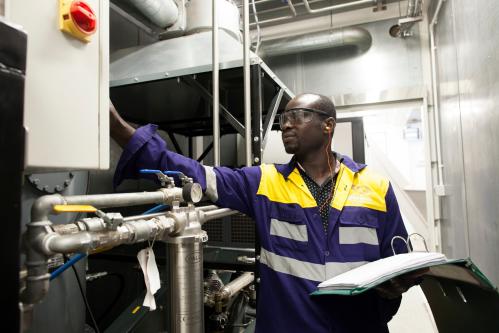The manufacturing industry has been a significant part of the U.S. economy for decades, but it now faces critical challenges with the emergence of automation and other technologies. Recently, Governance Studies at Brookings hosted the eighth annual John Hazen White Forum on Public Policy to discuss the future of manufacturing, as well as a new Brookings survey on public attitudes toward the industry in the U.S.
The first panel featured Rep. David Cicilline (D-R.I.), Molly Kinder of New America, and John Hazen White, Jr., president and CEO of Taco, Inc. The second panel featured Buckley Brinkman of the Wisconsin Center for Manufacturing and Productivity (WCMP), David Brousell of the National Association of Manufacturers (NAM), and Cheryl Merchant, president of the Taco family of companies. Darrell West, director of the Governance Studies program at Brookings, moderated both panels.
The changing image of manufacturing
West began by asking the first panelists what their outlook on the future of the industry was. Cicilline said he was optimistic given that the public perception of the importance of manufacturing was high; 58% of participants in the Brookings survey viewed the industry as vital to the U.S. economy. He added that although survey participants expressed concern over the industry’s future, structured workforce training programs could help build essential skills for young people seeking to enter the manufacturing sector.
Kinder, whose research has focused on interviewing workers in industries impacted by changing technologies, explained that automation was an inevitable phenomenon in the labor market. “The jobs that are at most risk in manufacturing are the ones that have the least education requirements and [are] the least skilled,” she said. She advocated for a multisectoral approach in ensuring that the workforce that has benefited historically can continue to do so through an understanding of changing trends.
John White of Taco Inc. thinks manufacturing can still thrive in America: “There is a future for manufacturing, and it’s an exciting one. … The possibilities are there.” #USmfg pic.twitter.com/624FHsoLXh
— Brookings Governance (@BrookingsGov) July 17, 2019
White mentioned the “baby boomer exodus”—the retirement of the oldest generation of workers from the industry—as being a particular challenge for manufacturing. Companies in the U.S. must re-evaluate the changing demographics of the workforce and adjust their practices to appeal to young workers.
Education and workforce training
Cicilline elaborated on the necessity of improving and adapting workforce training programs, primarily through early investment in career and technical education in high schools. He further argued that to remain a leader in global manufacturing, the U.S. would have to focus on building public-private partnerships to ensure workforce training would both address the skills gap and lead to job placement for young people.
Kinder added there were two challenges facing career preparedness for the future of manufacturing: attracting high-skilled workers to the industry pipeline, and repositioning existing workers to handle the industry’s emerging technical and skill challenges.
White discussed the role of private companies in worker training. He explored the introduction and development of the Taco Learning Center, a program that was implemented in the 1990s for employees of Taco, Inc. to receive continuing training as their positions evolved. Various elements of the learning center—whether it was in-house GED, bachelor’s, and master’s degree programs to summer camps for children—allowed employees to both gain foundational skills along with the necessary tools to move up within the workplace.
Manufacturing and the future of work
Brinkman discussed the WCMP’s efforts to analyze manufacturing in Wisconsin and develop plans to allow individual manufacturers to grow their productivity by 30% or more, warning against efforts to implement technology too quickly. He suggested that manufacturers needed to instead focus on other areas: As the skills gap translates into a shortage of workers, the manufacturing workforce in Wisconsin is projected to remain flat for the next 20 years. Expanding this workforce, according to Brinkman, is key to increasing manufacturing productivity.
Brousell, who leads the NAM’s efforts to help manufacturing companies transition to the digital age, explained that new technologies like AI and collaborative robots would lead companies to adjust their organization structures. He called on manufacturing leaders to foster a “digital acumen” among workers and ensure that data is leveraged effectively within organizations to cultivate greater synchronicity.
3 big challenges to the future of #USmfg, per @DRB1:
1️⃣ New technologies like AI and automation
2️⃣ Understanding how these changes will change company structure
3️⃣ Figuring out the impact of these changes on company leadership— Brookings Governance (@BrookingsGov) July 17, 2019
Merchant said the benefit of greater access to information through technology is that it has the potential to lead employees to feel more engaged in their fields. “Leaders have the responsibility of making people feel fulfilled,” she noted.
West brought up the issue of the government’s role in helping the manufacturing industry in its transition phase, and all panelists mentioned the critical relationship between the government, manufacturing companies, and local colleges and universities—particularly new public education programs that encourage young people to develop the technical skills and experience to adapt to modern manufacturing. “We need the government to put in place policies and incentives for investment around the digital model,” Brousell said.
As the manufacturing sector transforms to be a part of the emerging digital economy, government and education will be essential in ensuring that the sector’s workforce needs are met. Moving forward, collaboration between policymakers, business leaders, and educators will be more relevant than ever in discussions regarding the future of manufacturing.





Commentary
Highlights: How public attitudes are shaping the future of manufacturing
August 2, 2019